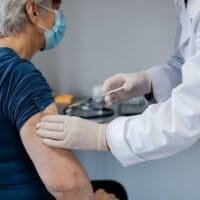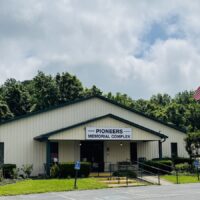More Kentuckians are testing positive for the coronavirus and more of them are being hospitalized with its COVID-19 disease, but state officials say the surge can be stopped if Kentuckians wear masks, keep 6 feet from each other and practice good hygiene.

“We are taking the type of aggressive action that should work if we can band together and get most Kentuckians wearing some form of facial covering, have that social distancing,” Gov. Andy Beshear said as he reported the daily numbers.
They included 603 Kentuckians hospitalized for COVID-19, which appears to be a record, and 145 of them in intensive care, the most since the first month of the pandemic. Beshear said the share of Kentuckians testing positive for the virus in the last seven days was 4.92 percent, also the highest since those days, when tests were largely limited to people with symptoms.
“That is a concern, and it shows it’s not just an increase in testing” that is driving up the case numbers, Beshear said. Becker’s Hospital Review offers a list of states ranked by the average of positive results in coronavirus tests over the last seven days; Kentucky ranked 20th.
Beshear said he disagreed with Louisville health officials’ advice that people there get tested only if they have symptoms. “I still think we have enough testing capacity,” he said, while acknowledging that is is worried about that supplies of testing reagents will run short.
He reported 518 new cases, less than the average of the previous three days. A better indicator, the seven-day rolling average, rose by six, to 565.
The governor reported three more COVID-19 deaths, but added, “I think we need to expect that we will see in the coming weeks a significant increase in that,” due to the surge in cases. The fatalities were a 49-year-old woman in Simpson County, who Beshear said had underlying health conditions; a 69-year-old woman in Allen County and 81-year-old man in Webster County. They raised the death toll to 677.
Noting that the Republican governors of Ohio and Indiana issued mask orders like the one he issued July 9, the Democratic governor said, “This should tell you that the step we took was the right step,” and said it would make the regional response more effective.
Also, “It should show you that there’s no political division in what is the right public-health response,” he said. “We all agree that one of the most important things we can do right now is encourage people to wear facial coverings. … This’ll be the number-one thing to determine if we can keep our economy open and this will be the best tool to try to get our kids back into school.”
Health Commissioner Steven Stack said at least one Kentucky hospital has accepted a COVID-19 patient from a sister hospital in Tennessee, where hospitals are filling up with them.
As for Kentucky’s recent surge, Stack said, “Whether that turns into a little hill, relatively speaking, or a big mountain, is entirely dependent on the actions of Team Kentucky. We can blunt this curve just like we flattened the first one.”
The first curve was flattened by shutting down most of the state’s economy. The White House Coronavirus Task Force has recommended that the state close down bars and cut restaurants’ capacity to 25 percent from 50 percent, but Beshear said he would do that “if we see a sharp uptick in cases.” He and Stack reiterated that they hope to see masks having an effect on case numbers by next Tuesday.
Alluding to President Trump’s new posture toward the pandemic, Beshear said, “I’m hopeful. We’re seeing a lot of people out there doing the right thing. We’re seeing a lot of other people coming around. We’re seeing people on the national stage wearing a mask and saying it’s patriotic.”
As he has resumed daily briefings, Beshear has also returned to telling encouraging stories posted on social media. One Wednesday was that of Rhonda King of Louisville, who was in intensive care for three months, much of it on a ventilator in a medically induced coma, but went home Tuesday. Beshear said the story had several heroes, including the recovered COVID-19 patient who donated blood plasma that King received and King’s husband, who called her three times a day.
Other metrics: Two websites that estimate reproduction rates for the virus say Kentucky’s rate is 1.23, meaning that every 100 infected people would infect 123 others. Epidemiologists like to keep the rate below 1.1. On Tuesday, Kentucky had the highest estimated rate, 1.37, on the Rt.live site, but it recalculates rates every day; it now says the rate has been 1.23 since July 12.
The CovidActNow site also estimates rates for counties with enough data; counties with estimated rates higher than the state rate are Oldham (site of a virus outbreak in a prison), 1.85; Harlan, 1.47; Jefferson, 1.25; and Ohio, 1.24.
Counties with more than 10 new cases Wednesday were Jefferson, 215; Fayette, 41; Kenton. 37; Hopkins, 33; Boone, 23; Shelby, 22; Graves, 21; Adair, 19; Logan, 19; Warren, 19; Butler, 14; Jackson, 14; Campbell, 13; Edmonson, 12; and Grayson, 11.
Another prison: The federal prison near Manchester is the fifth correctional facility in Kentucky to have an outbreak of the virus. The Bureau of Prisons reported that 39 inmates and five employees were infected, and one inmate has recovered from an infection.
The prison “houses a daily average of 1,082 inmates ranging in age from 20 to 74, according to a federal audit conducted in February. It employs 277 people,” reports John Cheves of the Lexington Herald-Leader. “The 240-acre facility includes a medium-security prison that held 950 people in February and a minimum-security satellite camp that held 138 people.”
In other COVID-19 news Wednesday:
- Beshear reported that 31 more residents and 22 more staff in long-term-care facilities had tested positive for the virus, raising the respective totals to 2,276 and 1,243. Two more deaths raised that total to 451. “We do think that it’s stabilizing, but as long as we have COVID-19 its going to be a fight,” Beshear said.
- Five more employees and three more children attending child-care centers tested positive, raising the respective totals to 30 and 21. Beshear said 36 centers now have at least one case associated with them.
- Stack urged parents whose children need vaccinations to get them, and said people who need medical care shouldn’t hesitate to seek it. “The hospitals are much better prepared now,” he said.
- He said “a small number” of deaths previously listed as related to COVID-19 have been taken off that list by a review committee. “We’re committed to being honest and open and trying to be as credible as possible,” he said. “They know a lot more about how to keep people safe.”
- Beshear said economizing by state agencies means that the state won’t end the 2019-20 fiscal year with a shortfall, but it will need help from the federal government to avoid record budget cuts of 13 to 17 percent in the fiscal year that began July 1. He said he will talk to Senate Majority Leader Mitch McConnell about it: “I think he knows how much we need this.”
- Franklin County Public Schools will reopen Aug. 26 with “100 percent virtual instruction,” Valerie Honeycutt Spears reports for the Herald-Leader. A separate article explores the pros and cons of school reopenings, and notes a study showing that school-age children can spread the virus just as well as adults, especially as they get older.
- WDRB provides a transcript from Dr. Jason Smith, chief medical officer at UofL Health, that addresses the recent spread of the virus, covering such topics as death rates, testing, long-term impacts of the virus and the effectiveness of masks.
- WFPL has a Q-and-A transcript with a pandemic expert on mask orders and school re-openings. Dr. Gerald Keusch, citing studies to support his claim, said, “There’s no question in my mind that the universal use of masks in public spaces is an effective, simple, cheap behavioral tool. This is totally separate from the value of contact tracing and spacing, both things that are relatively easy to do and were neglected during our initial reopening. The problem is that, like everything on the public health side, we’re unprepared to do it effectively. These measures are all interconnected, and they all need to be in place to get this under control.”
- Drew Altman of the Kaiser Family Foundation writes for Axios that over a 14-day period ending July 10, new cases in long-term care facilities rose by 18% across the 23 states, including Kentucky, for which data are available. His bottom line: “The lesson for long-term care facilities may be the same as the lesson for schools: There is no way to get a handle on coronavirus in one setting without first controlling community spread overall.”
- Derek Thompson reports for The Atlantic about how long COVID-19 immunity may last, saying a recent study showing it could be lost in months only looked at one part of the issue.





